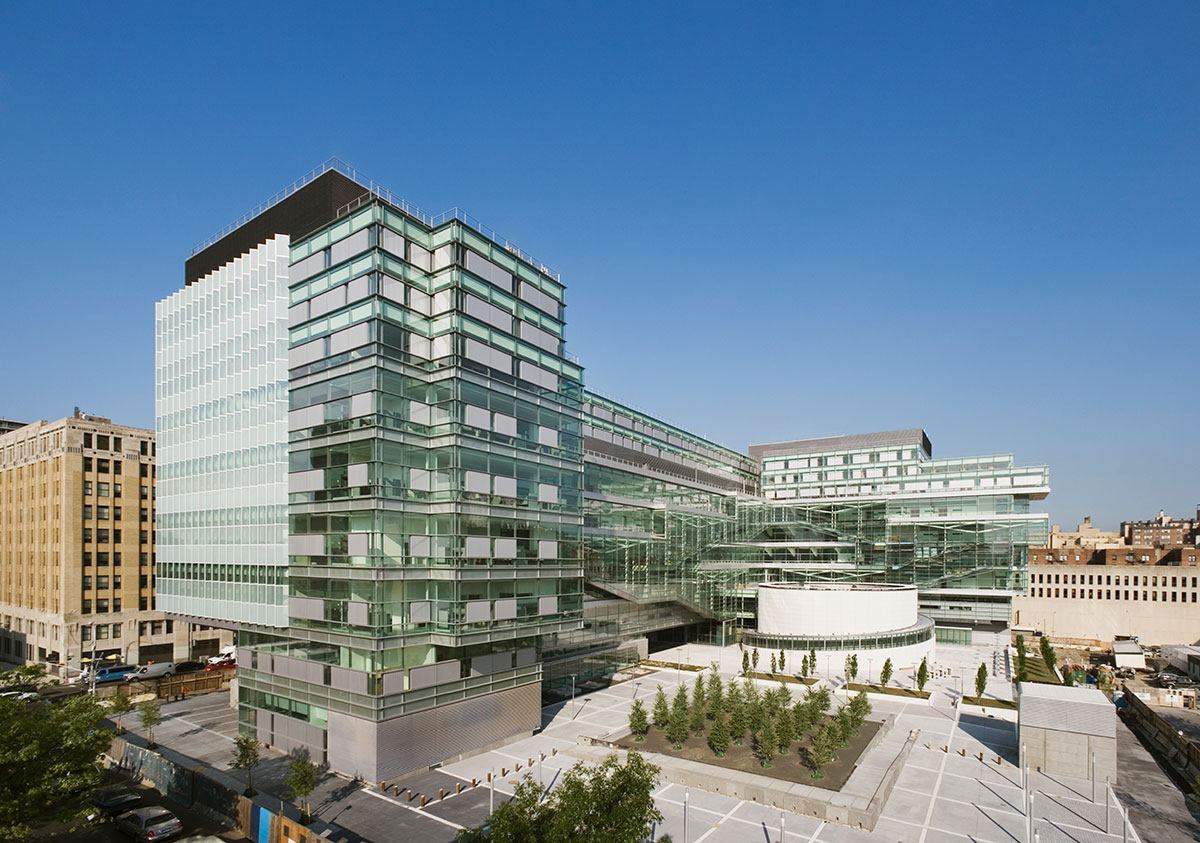Bronx County
Hall of Justice

161st and 162nd Streets between Sherman and Morris Avenues
Rafael Viñoly
2001-2007
Since 1916, when the Borough Courthouse opened at Third Avenue, 161st Street, it has been the axis of the Bronx’s legal district. Rafael Viñoly’s Hall of Justice, opened in Summer 2007, is the fourth and largest courthouse to be built on the street—with 47 courtrooms, one of the largest in the country. At first view, it seems, despite its contemporary idiom, to share the conviction of its neighbors that judicial architecture must represent strength and authority.
Viñoly holds to the frontage line established by Harrison and Abromowitz’ Family and Criminal Court (1977), a concrete monolith immediately to the east, erecting an impassive nine-story wall, this time in vertical folds of tinted glass and aluminum. Just short of midway along the Hall of Justice’s two-block-long façade, a narrow street-level canopy summons prospective jurors to the public entrance of the building, from which, once through the X-rays and metal detectors, they cross a lobby to their 495-seat assembly hall.
But the ordinary pedestrian, continuing east along 161st Street, comes upon an unexpected breach in the façade, permitting him to pass beneath the intimidating courthouse and into a different world, a two-block plaza unbounded by walls. This concrete plain, relieved by plantings, benches, and sculpture, holds the juror’s assembly hall, revealed now to be free-standing, two-story cylinder tucked behind the courthouse. Around it an enclosed spiral corridor curls to a roof rock garden. To its east is an elevated square platform, planted with rows of trees.
Viñoly has intentionally kept the tall, narrow, courthouse building to the south and west edges of his site, making room for this broad plaza which provides a transition between trafficked, busy 161st Street and the quieter blocks, with several schools and low apartment buildings, to the north. With its open horizon and abstract shapes, the plaza is an important supplement to the courthouse’s representation of Justice.
When the pedestrian, having slipped into this tranquil space, turns back to look at the building he’s just passed beneath, he sees a figuratively, as well as literally, different face from the one on the street side. Here the walls are sheets of transparent glass that follow the long horizontals of the corridors. Communication between the floors is made visible in the form of glass-enclosed stairways that protrude over the courtyard, zigzagging upward like Renzo Piano and Richard Rogers’ well-known exterior escalator at the Pompidou Center in Paris. Elegant white metal trusses, also visible through the facade, support the stairways from above.
Filled with people when the courts are in session, these stairways and corridors will present a human (and “transparent”) aspect of justice, while the reverse side of the building, where the courtrooms are located, maintains its institutional rigor. The plaza’s contemplative spaces (such as the rooftop Zen garden), its continuity with the neighborhood, and the visible public galleries hanging above it bring to mind meliorative qualities of law that are ignored in a conventional courthouse’s strenuous assertion of authority.
Unfortunately, Viñoly arrived at his vision of a public-friendly court building at the worst possible time. In the planning stage when the Murrah Federal Building in Oklahoma City was attacked, the Hall of Justice’s cornerstone was laid in August 2001. As a consequence, glass for the walls overlooking the plaza had to be redesigned to survive testing with explosives at the White Sands Missile Range, and the lobby made bulletproof. The 200-space garage was located beneath the meditative plaza, so that dangerous vehicles could be kept from beneath the courthouse. And it’s reported that the idealistic architect’s Zen garden may remain closed to the public.
David Bady
Photographs:
© Rafael Viñoly Architects